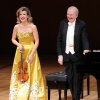
Young artists can’t make it big without playing the big concertos — long, technically difficult works that take years to perfect. By this metric, siblings Sheku and Isata Kanneh-Mason have certainly earned their respective places in the spotlight.
Last season, Bay Area audiences were treated to the former soloing in Dmitri Shostakovich’s Cello Concerto No. 1 with the San Francisco Symphony, and it surely won’t be long before the latter digs into her piano repertoire with the orchestra here. But for anyone who somehow missed the siblings’ previous local performances, including a joint recital at Davies Symphony Hall in 2022, the pair’s return on Sunday, June 1, as part of the Symphony’s Great Performers Series, made a most illuminating introduction to their larger-than-life artistry.
Otherworldly legato distinguished Sheku’s performance, especially in the evening’s first work, Felix Mendelssohn’s songlike Cello Sonata No. 1. Each movement of the piece arced with the appropriate drama, but the phrasing was mostly subtle, the sound refined. Playing with husky, high-up-the-string fingerings and his bow near the fingerboard, Sheku created sounds to make the listener lean in.

You’d be forgiven not to have appreciated, at first, the magnitude of Isata’s contribution — her physical movements at the keyboard were that efficient. But these pretty cello melodies wouldn’t stay afloat without the pianist’s finger-twisting figurations, and Isata’s flowed easily. She imbued the dangling chords of Mendelssohn’s Andante with a brooding elegance. She also beautifully balanced the cascading arpeggiations in the other piano-centric piece on Sunday’s first half, Gabriel Fauré’s urgent Cello Sonata No. 1.
Even Francis Poulenc’s frothy Cello Sonata, which featured at the end of the program, had surprising depth between the pert march of its first movement and the zany dance of its finale. The rapturous Cavatine that came between was a master class in the slow build, Isata’s fingers here coaxing bottomless expression from the keys.
None of these sonatas are much played, and all were welcome on this recital. But the real revelation among the evening’s repertoire was a two-movement character piece written expressly for the Kanneh-Masons by 41-year-old British composer Natalie Klouda.
There’s plenty of rustling and rattling in Klouda’s Tor Mordôn, whose title is derived from the ancient languages of Great Britain and means “sea mount of light.” The composition’s extravagant landscapes swarm with dragons and frogs, the stuff of Antiguan and Welsh legends — a nod to the Kanneh-Masons’ heritage. On Sunday, it all translated wonderfully into music.
Over Isata’s murmuring lines, Sheku’s glissandos roiled. His icy harmonics sliced up and down the fingerboard; her harmonies hung in strange clouds. With luck, the Kanneh-Masons will lend Tor Mordôn to other performers. But have no doubt about it, this is their piece.
This story was first published in Datebook in partnership with the San Francisco Chronicle.




